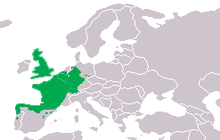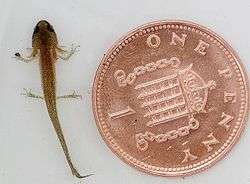Palmate newt
| Palmate newt | |
|---|---|
.jpg) | |
| Scientific classification | |
| Kingdom: | Animalia |
| Phylum: | Chordata |
| Class: | Amphibia |
| Order: | Caudata |
| Family: | Salamandridae |
| Genus: | Lissotriton |
| Species: | L. helveticus |
| Binomial name | |
| Lissotriton helveticus Razoumowsky, 1789 | |
| Subspecies | |
|
L. helveticus helveticus | |
 | |

The palmate newt (Lissotriton helveticus) is a species of newt found in most of Western Europe, including Great Britain. It is protected by law in all countries where it occurs, and is thought to be extremely rare to endangered in the Netherlands, Belgium, and Luxembourg, and vulnerable in Spain and Poland, but common elsewhere.
Description
The palmate newt is a relatively small species, males reaching only about 8.5 cm and females 9.5 cm.[2] The base colour of both sexes is olive-green or brown, and a dark mask-like line runs across the head through the eyes; males and some females have a dark spotting on their backs. Sometimes confused with the smooth newt, the palmate does not have the spotted throat of the smooth newt, but both sexes have yellow or pale-orange bellies that can show some spotting.
The male has webbed hind feet and a low, smooth crest along the back that continues into a slightly higher crest on the tail, ending in a thread-like tip during the breeding season of April - May. Males can also have enlarged cloacal regions when close to breeding due to the spermatophores exerting pressure on the cloacal tissue. The crest and filament become less obvious and may disappear at other times when they become terrestrial. Males also have marked dorsolateral ridges, giving them a rather square cross-section. Females grow to 10 cm (3.9 in) and males to 8.5 cm (3.3 in). During the breeding season, they are active during the day, as well as night, but outside this period, activity is restricted to rainy or humid nights.
Habitat, reproduction and feeding habits
It lives in ponds, lakes, canals, marshes, forests, pasture, or agricultural land, sometimes in acid pools on upland moorland or coastal areas. It spends the breeding season in water, laying 100 to 300 eggs which hatch into larvae in about two to three weeks, and then metamorphose after a further six to 9 weeks. In colder areas, the larvae often overwinter in the water and then metamorphose the next year. They become sexually mature in the second year, but neoteny is also known to occur in this species. Adults hibernate on land under logs and stones between November and March, or more rarely in water.
They feed on invertebrates, small crustaceans, planktonic animals, daphnia, and frog tadpoles. They are also known to display cannibalistic tendencies and they can live for up to 10 years.
Subspecies
- L. h. helveticus; northern Germany to northeastern Spain.
- L. h. punctillatus; Sierra de la Demanda area, Iberian System, Spain.[3]
- L. h. alonsoi; northwestern Iberia.
References
- ↑ Arntzen, J.W.; Beebee, T.; Jehle, R.; Denoël, M.; Schmidt, B.; Bosch, J.; Miaud, C.; Tejedo, M.; Lizana, M.; Martínez-Solano, I.; et al. (2004). "Lissotriton helveticus". IUCN Red List of Threatened Species. Version 2006. International Union for Conservation of Nature. Retrieved 2007-06-11.
- ↑ Lissotriton helveticus
- ↑ Taxonomy of Some of the Salamandrids - Triturus helveticus and its subspecies
External links
| Wikispecies has information related to: Lissotriton helveticus |
 Media related to Lissotriton helveticus at Wikimedia Commons
Media related to Lissotriton helveticus at Wikimedia Commons- "The Life Cycle of the Newt". British Film Council. 1942. Retrieved 24 April 2014.
